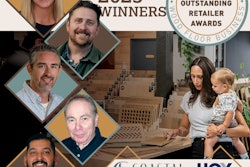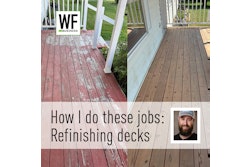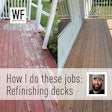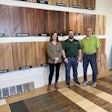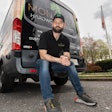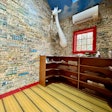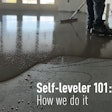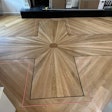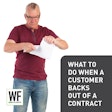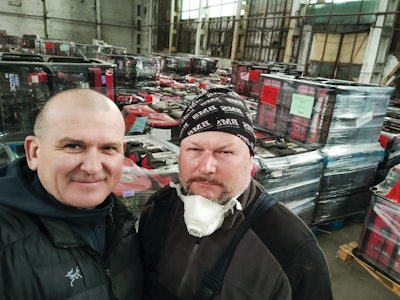
In 2000, at age 28, I left my native Ukraine to move to Canada. I had graduated from Pedagogical University in Ukraine after studying foreign languages, but in Canada, I quickly ended up in the wood flooring industry. I could never have envisioned the way global and personal circumstances would change, and how my involvement in this industry would take me on a path to helping the people in my war-torn homeland.
I had developed relationships online and via the phone with many of the wood floor pros involved in Workcamp Parquet, which is a group of elite pros around the world who meet in Europe to work on real-life projects together. I wanted to meet them in person, so in January 2020 I traveled to Domotex Germany in Hannover, Germany … and right after is when COVID hit. I didn’t know what to do: Should I stay or go? I called my wife, and she reminded me that we had inherited an apartment from her mother in Mykolaiv, Ukraine. I went to visit my parents, who live in western Ukraine close to the Polish border, and moved into our apartment in Ukraine.
After a year of teaching English to the local business community in 2020, in 2021 I began working for a Ukrainian company called “Enjoy the Wood” that made incredible wooden maps. I was asked to set an exhibition for them for the first time on U.S. soil. It was in Charlotte, N.C., and I immediately fell in love with the city. I had plane tickets to move there to continue building the business on March 1, 2022—but Russia had other plans.
Even though almost all airlines were canceling flights to Europe because of fear of an invasion, barely anyone believed Russia would do what it did. I had to buy a train ticket to Odessa and to Poland, figuring I could make my way to the U.S. On the day I was going to leave, Feb. 24, I woke up at 5 a.m. to a deep thumping—Russian air forces were bombing a military base 1.5 miles away. I immediately got online and saw Russia was invading.
I was thinking, “OK, Alex, it’s time to go.” I was standing in the middle of my newly renovated apartment with a little backpack in my hands, realizing that I had no time to pack anything but a change of clothes. My biggest concern was for my daughter, who was 14 years old. Born and raised Canadian, she was staying with her aunt and uncle just outside of Kyiv, about 400 miles from where I was, to attend school. I called her uncle, but they were not convinced they should evacuate just yet.
I called my buddy who lived near me. We figured the safest place would be western Ukraine, so I joined him and his family in their car. A route that would normally take eight hours took 24. The one main artery toward the Polish border was packed, and gas stations were running out of gas and water—it was horrible.
That day around lunchtime my daughter sent me a text, terrified, because a missile had struck a supermarket only maybe 200 meters from where they lived. After that, they joined the chaos driving to western Ukraine. Once they made it, she and I were able to cross into Slovakia and then fly to Canada.
Once she was with her mother (my ex-wife), I went back to Charlotte, even though my original plan for Enjoy the Wood was now irrelevant—Russian troops destroyed their production facility and office. I wondered: What am I doing now? Amid all this uncertainty, I thought about going to the NWFA Expo in Tampa, but I wasn’t sure, and I thought about how I’d been out of the industry for a couple years … and then I said, this is my industry, and I want to go see everyone.
While I was there, someone happened to introduce me to Chris Yates, a wood floor pro from Nantucket, Mass., who had just gotten back from leading a group of people to Poland to help Ukrainian refugees. We began talking about how to help, and through him I met Ilija Kubie, a New Yorker, who was in Ukraine already and who was part of Chris’s team in Poland. Because of that, so much began.
 This destroyed playset was taken from Irpin, Ukraine, to be displayed at U.S. House of Representatives’ Rayburn Building in Washington, D.C., where we lobbied for help for Ukraine.
This destroyed playset was taken from Irpin, Ukraine, to be displayed at U.S. House of Representatives’ Rayburn Building in Washington, D.C., where we lobbied for help for Ukraine.
Through these connections, I ended up being part of a two-day event in Washington, D.C., where we advocated for Ukraine on Capitol Hill. We presented an artifact from Irpin, Ukraine: a children’s slide riddled with shrapnel and bullets. That led me to meet a wealthy donor who told me he had a huge pool of generators—12,000—and asked me: “Do you think you can take them to Ukraine and distribute them there?” With all the infrastructure being bombed out of existence in Ukraine, there was such a huge need for the generators, just for people to charge their phones or warm up their food. I thought: “I’ve got to take this on.”
And so we did it. With the help of the Ukrainian Congress Committee of America to cover shipping costs, the generators ended up being packed into 75 containers and shipped to Ukraine, and I went to Germany and then to Ukraine to manage the service center (the generators were returns and needed minor repairs) and distribution of them to people who live in the “gray zone” affected by the war. On many occasions, I went to deliver the generators myself. You can’t imagine the smile of someone who has been sitting in a war zone without power for seven months and suddenly sees someone arrive with a generator that won’t cost them a dime.
The person who introduced me to the donor of the generators is a doctor, and in his free time, he helps set up clinics in countries that are hit by disasters or war. Through him I also got involved with setting up a mobile dental clinic and mobile hospitals to save lives and provide much-needed dental care.
My involvement in all these projects in Ukraine happened in the course of three months, and it was intense. I had to travel to the front line several times to deliver the generators and firm up the placement of medical equipment with local authorities. Being close enough to hear the artillery going back and forth and traveling through destroyed areas was an eye-opening experience. You see the collapsed buildings and know there was someone underneath those floors.
I’m back in North Carolina now, as I need to support my family and myself, so I’m concentrating on getting my own wood flooring contracting business up and running. I’ll continue to work on Ukraine projects as I build my business. It’s amazing to look back at what we were able to do in Ukraine this year—and to to think it happened because I decided to go on a trip to reconnect with my wood flooring community. I realize that all the positive things that have happened are a result of a core philosophy I believe in: If there’s synergy, if you get a group of like-minded people, one plus one is always three. I believe there’s nothing impossible if you truly believe that this is the right thing to do.
Authors Note: Although I’m writing this in summer, before long, winter will be back in Ukraine, and there will be a huge need for everything from generators to warm clothing for orphans. Those interested in donating to help can go to www.oberig-26.org.















